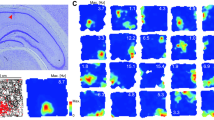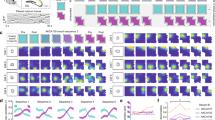Abstract
One reason the electrophysiological correlates of hippocampal neurons are of interest is the possibility that they reflect their representational properties, presumably spatial/relational ones. Stable spatial representations, based on activity of ensembles of hippocampal place cells, initially develop through a series of short-episodic spatial tunings. Hence these short-episodic spatial tunings are important for understanding the establishment of stable place fields. Studies of age-related changes in place cell activities traditionally focus on place fields. In the present study, we characterized the short-episodic spatial tunings (1-min bins) of hippocampal CA1 place cells of freely moving mice in a familiar cylinder arena, and compared these functions in young and old mice. Spatial tuning was expressed by spatial selectivity, which we found fluctuated across a 16-min recording session in both young and old mice. High spatial selectivity, which is mainly due to the low firing of a place cell out of the place field in young mice, was significantly higher in old mice. The high firing rate out of the place field was the main factor contributing to significantly lower spatial selectivity in old mice. In addition, young mice showed a broad peak in the spatial selectivity between 4 and 10 min. In contrast old mice showed no peak in the spatial selectivity during this time period. The stability of place fields after a 24-h interval was also lower in old mice than in young mice. The low spatial tuning and unstable place fields suggest that a hippocampal-based spatial representation was impaired in the old mice. Furthermore, we speculate that the age-related impairment in hippocampal inhibition system may be involved in the impaired spatial representation of hippocampal CA1 place cells in old mice.








Similar content being viewed by others
References
Ali AB, Bannister AP, Thomson AM (1999) IPSPs elicited in CA1 pyramidal cells by putative basket cells in slices of adult rat hippocampus. Eur J Neurosci 11:1741–1753
Austin KB, White LH, Shapiro ML (1993) Short- and long-term effects of experience on hippocampal place fields. Soc Neurosci Abstr 19:979
Bach ME, Barad M, Son H, Zhou M, Lu YF, Shih R, Mansuy I, Hawkins RD, Kandel ER (1999) Age-related defects in spatial memory are correlated with defects in the late phase of hippocampal long-term potentiation in vitro and are attenuated by drugs that enhance the cAMP signaling pathway. Proc Natl Acad Sci USA 96:5280–5285
Barnes CA, McNaughton BL (1980) Physiological compensation for loss of afferent synapses in rat hippocampal granule cells during senescence. J Physiol (Lond) 309:473–485
Barnes CA, Nadel L, Honig WK (1980) Spatial memory deficit in senescent rats. Can J Psychol 34:29–39
Barnes CA, Rao G, McNaughton BL (1987) Increased electrotonic coupling in aged rat hippocampus: a possible mechanism for cellular excitability changes. J Comp Neurol 259:549–558
Barnes CA, Suster MS, Shen J, McNaughton BL (1997) Multistability of cognitive maps in the hippocampus of old rats. Nature 388:272–275
Billard JM, Lamour Y, Dutar P (1995) Decreased monosynaptic GABAB-mediated inhibitory postsynaptic potentials in hippocampal CA! Pyramidal cells in the aged rat: pharmacological characterization and possible mechanisms. J Neurophysiol 74:539–546
Bostock E, Muller RU, Kubie JL (1991) Experience-dependent modifications of hippocampal place cell firing. Hippocampus 1:193–206
Dvorak-Carbone H, Schuman EM (1999) Patterned activity in stratum lacunosum moleculare inhibits CA1 pyramidal neuron firing. J Neurophysiol 82:3213–3222
Fenton AA, Muller RU (1998) Place cell discharge is extremely variable during individual passes of the rat through the firing field. Proc Natl Acad Sci USA 95:3182–3187
Hill AJ (1978) The first occurrence of hippocampal spatial firing in a new environment. Exp Neurol 62:282–297
Karnup S, Stelzer A (1999) Temporal overlap of excitatory and inhibitory afferent input in guinea-pig CA1 pyramidal cells, J Physiol (Lond) 516:485–504
Mizumori SJ, Kalyani A (1997) Age and experience-dependent representational reorganization during spatial learning. Neurobiol Aging 18:651–659
Mizumori SJ, McNaughton BL, Barnes CA, Fox KB (1989) Preserved spatial coding in hippocampal CA1 pyramidal cells during reversible suppression of CA3c output: evidence for pattern completion in the hippocampus. J Neurosci 9:3915–3928
Mizumori SJ, Lavoie AM, Kalyani A (1996) Redistribution of spatial representation in the hippocampus of aged rats performing a spatial memory task. Behav Neurosci 110:1006–1016
Moser EI (1995) Learning-related changes in hippocampal field potentials. Behav Brain Res 71:11–18
Muller RU (1996) A quarter of a century of place cells. Neuron 17:813–822
Muller RU, Kubie JL (1987) The effects of changes in environment on spatial firing of the hippocampal complex-spike cells. J Neurosci 7:1951–1968
Muller RU, Kubie JL, Ranck Jr JB (1987) Spatial firing pattern of hippocampal complex-spike cells in a fixed environment. J Neurosci 7:1935–1950
Nadel L, Eichenbaum H (1999) Introduction to the special issue on place cells. Hippocampus 9:341–345
O'Keefe (1999) Do hippocampal pyramidal cells signal non-spatial as well as spatial information? Hippocampus 9:352–364
O'Keefe J, Dostrovsky J (1971) The hippocampus as a spatial map. Preliminary evidence from unit activity in the freely-moving rat. Brain Res 34:171–175
Potier B, Krzywkowski P, Lamour Y Dutar P (1994) Loss of calbindin-immunoreactivity in CA1 hippocampal stratum radiatum and stratum lacunosum-moleculare interneurons in the aged rat. Brain Res 661:181–188
Rotenberg A, Mayford M, Hawkins RD, Kandel ER, Muller RU (1996) Mice expressing activated CaMKII lack low frequency LTP and do not form stable place cells in the CA1 region of the hippocampus. Cell 87:1351–1361
Save E, Nerad L, Poucet B (2000) Contribution of multiple sensory information to place field stability in hippocampal place cell. Hippocampus 10:64–76
Shen J, Barnes CA, McNaughton BL, Skaggs WE, Weaver KL (1997) The effect of aging on experience-dependent plasticity of hippocampal place cells. J Neurosci 17:6769–6782
Shetty AK, Turner DA (1998) Hippocampal interneurons expressing glutamic acid decarboxylase and calcium-binding proteins decrease with aging in Fischer 344 rats. J Comp Neurol 394(2):252–269
Shetty AK, Turner DA (1999) Aging impairs axonal sprouting response of dentate granule cells following target loss and partial deafferentation. J Comp Neurol 414:238–254
Smith TD, Calhoun ME, Rapp PR (1999) Circuit and morphological specificity of synaptic change in the aged hippocampal formation. Neurobiol Aging 20:357–360
Tanila H, Sipila P, Shapiro ML, Eichenbaum H(1997a) Brain aging: impaired coding of novel environment cues. J Neurosci 17:5167–5174
Tanila H, Sipila P, Shapiro ML, Eichenbaum H(1997b) Brain aging: changes in the nature of information coding by the hippocampus. J Neurosci 17:5155–5166
Tanila H, Shapiro ML, and Eichenbaum H (1998) Discordance of spatial representation in ensembles of hippocampal place cell. Hippocampus 7:613–623 [erratum published in Hippocampus 8:83]
Thompson LT, Best PJ (1990) Long term stability of hippocampal unit activity recorded from freely behaving rats. Brain Res 509:299–318
Wiener SI, Paul CA, Eichenbaum H (1989) Spatial and behavioral correlates of hippocampal neuronal activities. J Neurosci 9:2737–2763
Wilson MA, McNaughton BL (1993) Dynamics of the hippocampal ensemble code for space. Science 261:1055–1058
Acknowledgements
We thank the Multiple Sclerosis Society of Canada for salary support and the Human Frontier Science Program Organization for a short-term training fellowship with Dr. R. Muller at SUNY-Brooklyn, NY, USA, who was a consultant on this project. This research was supported by the Canadian Institutes of Health Research and the Ontario Mental Health Foundation.
Author information
Authors and Affiliations
Corresponding author
Rights and permissions
About this article
Cite this article
Yan, J., Zhang, Y., Roder, J. et al. Aging effects on spatial tuning of hippocampal place cells in mice. Exp Brain Res 150, 184–193 (2003). https://doi.org/10.1007/s00221-003-1396-6
Received:
Accepted:
Published:
Issue Date:
DOI: https://doi.org/10.1007/s00221-003-1396-6




